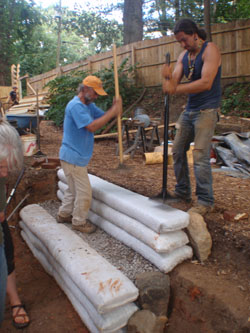
Earthbags are most commonly used for houses, schools, greenhouses, survival shelters and water tanks. Another very practical use for earthbags is retaining walls. These can range from massive retaining walls along highways to small garden walls. This article is about terracing the land with low retaining walls to create pathways and to control water runoff.
Most people use ordinary polypropylene earthbags filled with soil or gravel for making retaining walls. Exposed bags like these need to be protected from UV damage with plaster. Walls like this are quite common. Another good option is to create living retaining walls made with mesh bags that will support plant growth in addition to retaining the earth.
My Earthbag Building Guide has more suggestions for building earthbag retaining walls. They make great starter projects around the home, because they give you an opportunity to practice building with bags on a small scale. You can sculpt and terrace the land before or after building your sustainable home and the rest of your homestead.
Image source: Lily Ann Fouts

Hi Owen,
I am trying to understand retaining walls with earthbag. You suggest a “good option is to create living retaining walls made with mesh bags that will support plant growth in addition to retaining the earth”.
My question is; Do we tamp the mesh bags normally? And isn’t tamped soil not a good substrate for plant growth?
I would tamp lightly to level and stabilize the wall. Use only on gradual slopes.
What’s your best recipe for outdoor plaster?
Regular cement plaster.